
| Author: | Lamothe et al., 1984 |
| Age: | Paleoproterozoic |
| Reference section: | None |
| Type area: | Spartan Lake area (NTS sheet 35G10) |
| Geological province: | Churchill Province |
| Geological subdivision: | Ungava Orogen / Ungava Trough / Northern Domain |
| Lithology: | Detrital sedimentary rocks and volcaniclastic rocks |
| Type: | Lithostratigraphic |
| Rank: | Group |
| Status: | Formal |
| Use: | Active |
None
Background
The Spartan Group was introduced by Lamothe et al. (1984) to describe an assemblage of phyllite and quartzite overthrusting the Chukotat Group along the Bergeron Fault. It also includes sedimentary rocks assigned to the Perrault Group by Hocq et al. (1994).
Description
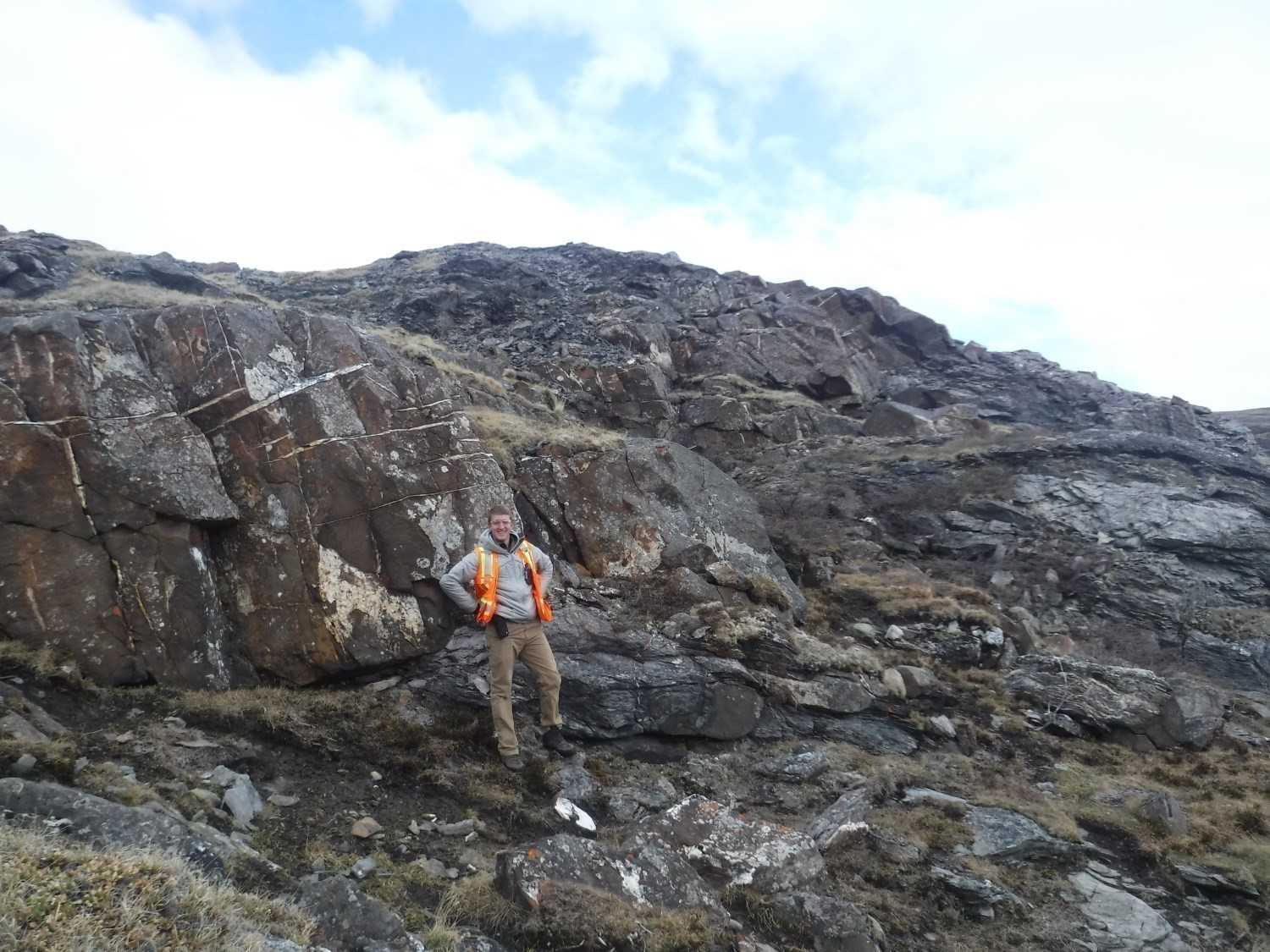 In the eastern portion of the Spartan Group, which extends from Spartan Lake to the area east of Watts Lake, the unit consists mainly of phyllite. Towards the structural top, to the north, the unit contains siltstone interbeds or, more locally, dolomitic beds (Lamothe et al., 1984; St-Onge and Lucas, 1993; Mathieu and Beaudette, 2019). In the central and western portions of the Spartan Group, detrital sedimentary rocks consist of an assemblage of decimetric to metric beds of lithic or feldspathic metawacke with layers of basaltic lava, and crystal or lapilli tuff. The composition of sedimentary rocks suggests a more proximal source than in the eastern portion. Several mafic and ultramafic sills and dykes intrude into sedimentary rocks.
In the eastern portion of the Spartan Group, which extends from Spartan Lake to the area east of Watts Lake, the unit consists mainly of phyllite. Towards the structural top, to the north, the unit contains siltstone interbeds or, more locally, dolomitic beds (Lamothe et al., 1984; St-Onge and Lucas, 1993; Mathieu and Beaudette, 2019). In the central and western portions of the Spartan Group, detrital sedimentary rocks consist of an assemblage of decimetric to metric beds of lithic or feldspathic metawacke with layers of basaltic lava, and crystal or lapilli tuff. The composition of sedimentary rocks suggests a more proximal source than in the eastern portion. Several mafic and ultramafic sills and dykes intrude into sedimentary rocks.Spartan Group 1 (pPsp1): Siltstone, Phyllite, Sandstone Locally Conglomeratic
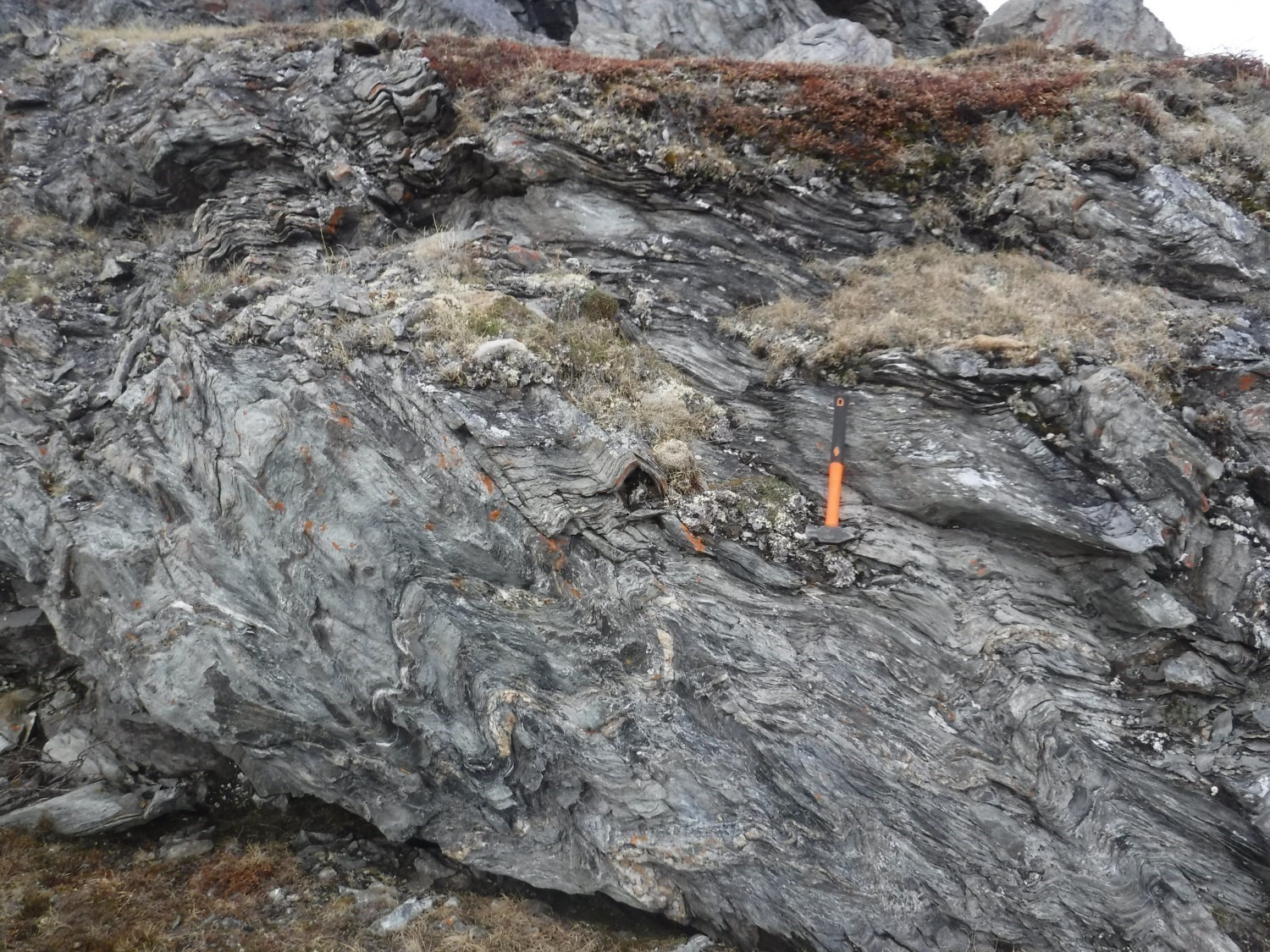
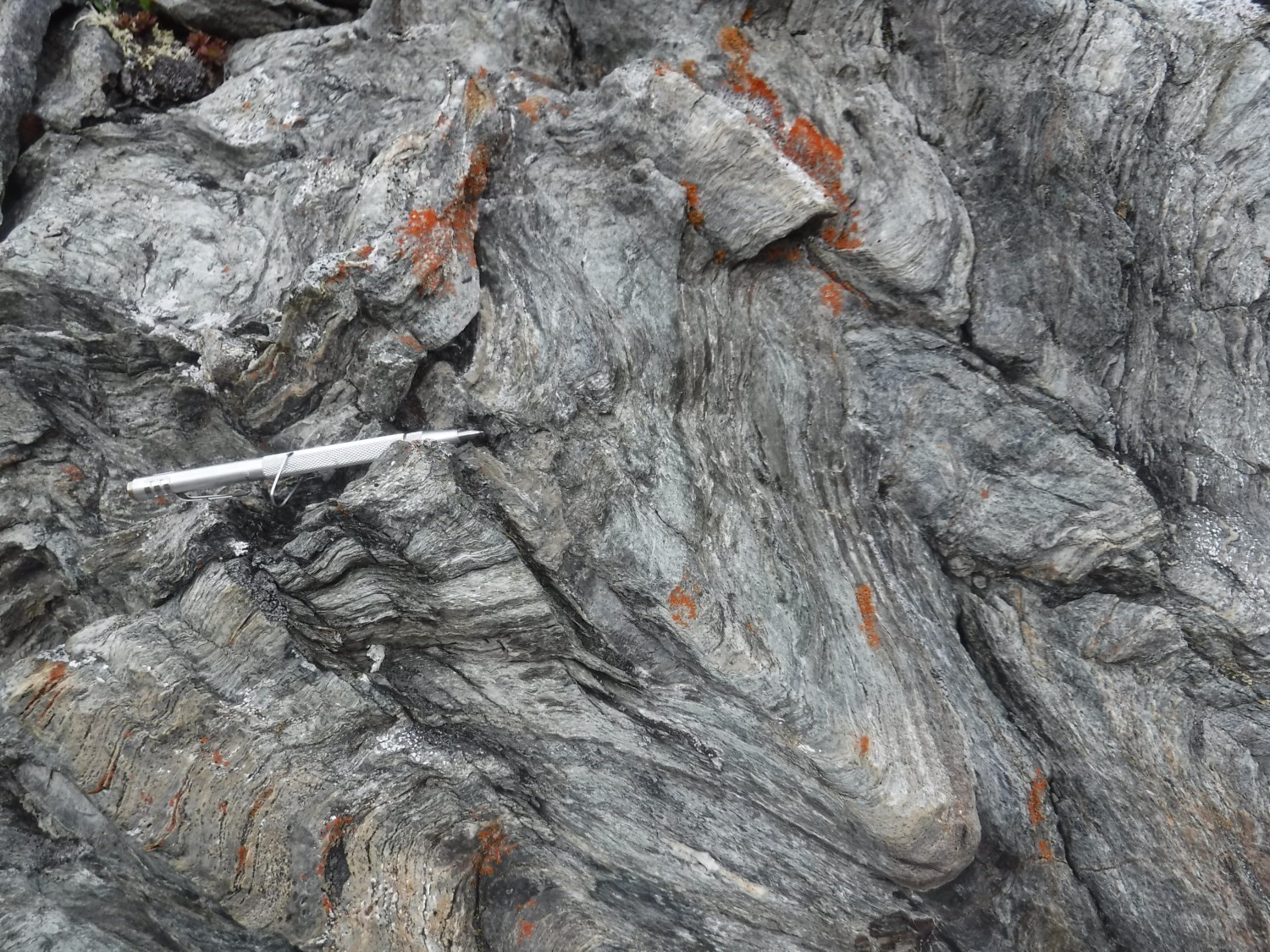
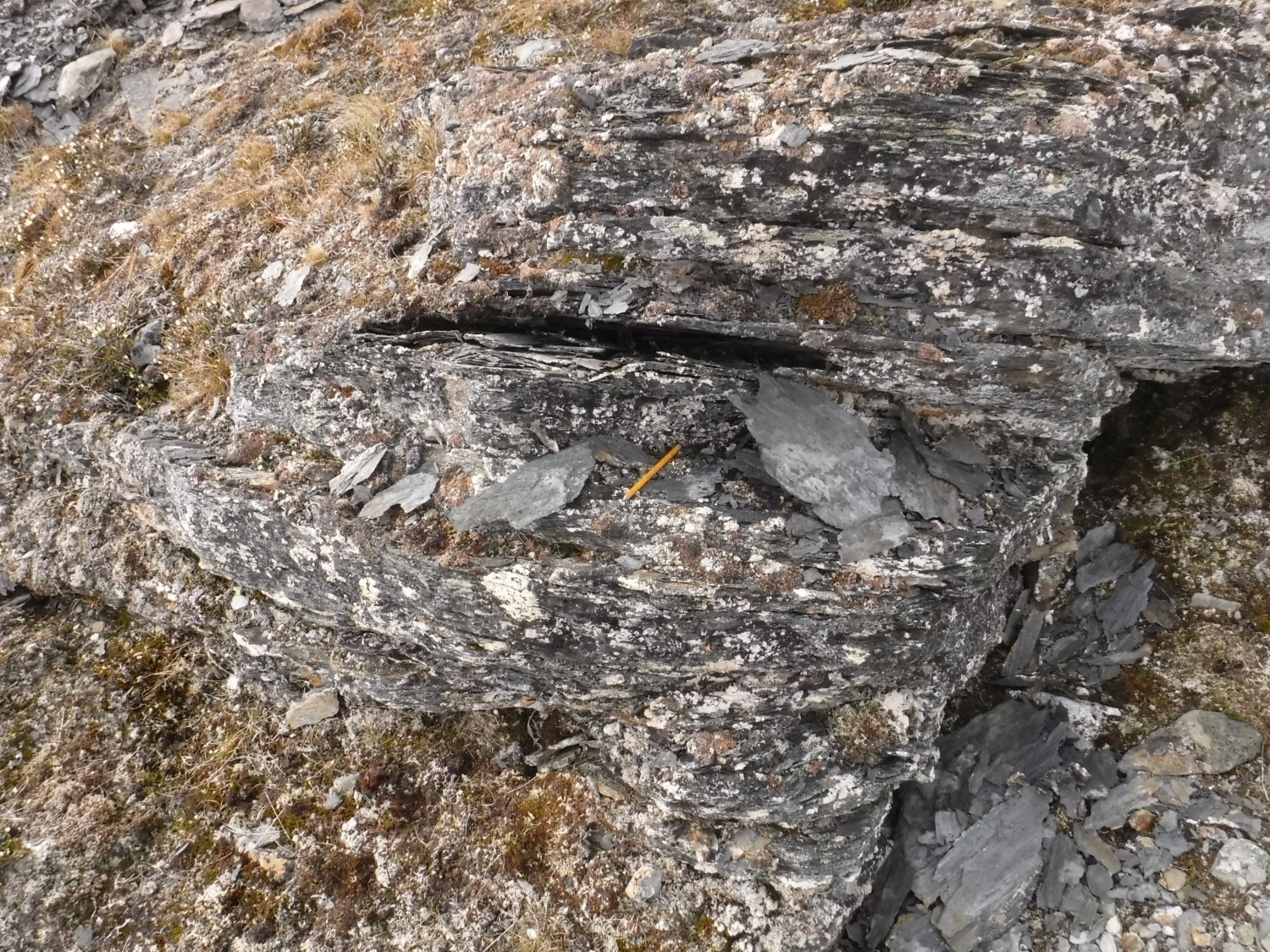

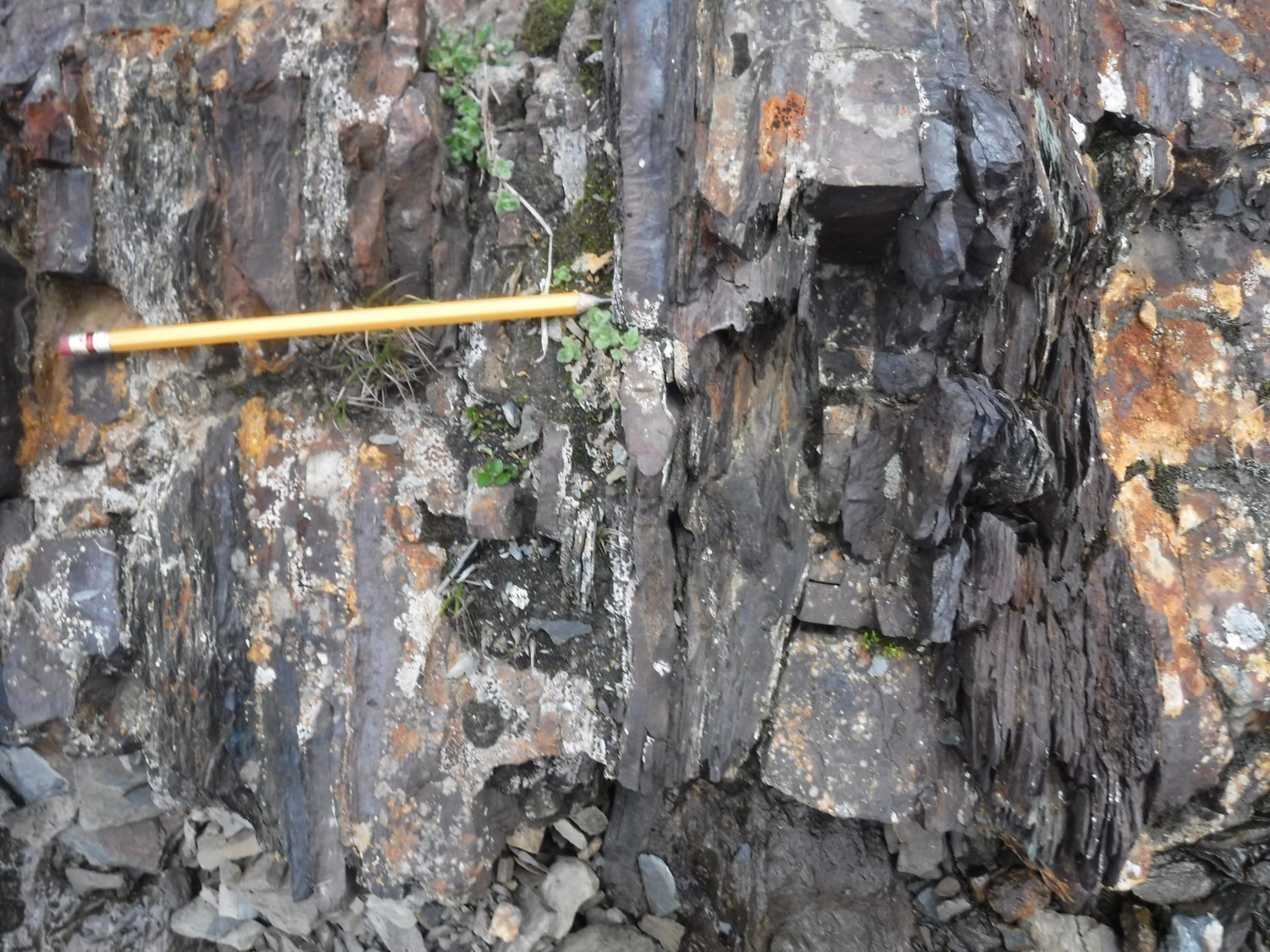 This subdivision consists of a clastic sedimentary sequence composed of dark laminated phyllite, wacke, conglomerate, sandstone and mudstone. Wacke generally contains a high proportion of ferromagnesian minerals, which could come from mafic volcanics of the Parent Group. There is also fine-grained quartzite, whose primary structures are obliterated by a strong schistosity parallel to bedding (Hocq et al., 1994; St-Onge and Lucas, 1993).
This subdivision consists of a clastic sedimentary sequence composed of dark laminated phyllite, wacke, conglomerate, sandstone and mudstone. Wacke generally contains a high proportion of ferromagnesian minerals, which could come from mafic volcanics of the Parent Group. There is also fine-grained quartzite, whose primary structures are obliterated by a strong schistosity parallel to bedding (Hocq et al., 1994; St-Onge and Lucas, 1993).The eastern portion was mapped in more detail by Mathieu and Beaudette (2019). It is overthrusted to the north by the Watts Group; to the south, it overthrusts the South Domain Chukotat Group. In this area, the Spartan Group consists of very fine to fine-grained metasedimentary rocks with millimetric to centimetric primary bedding, which is transposed into planes of the main schistosity. The overall appearance is very homogeneous, displaying a medium to dark grey alteration patina, glossy along the main schistosity plane, and light to medium grey in fresh exposure.
Metasedimentary rocks vary in composition from quartzitic arenite to siltstone, including minor amounts of wacke. The grain size used as a sedimentary classification criterion should be taken with caution, as the deformation intensity affecting the Spartan Group in this area results in grain size reduction. Beds are saccharoidal and composed of quartz (5-90%), plagioclase (uncertain content due to the absence of twinning) and thin muscovite flakes (10-95%). Quartzitic beds are overwhelmingly more abundant than flexure micaceous beds. Locally, medium-grained quartz-plagioclase clusters form sigmoids. Secondary phases are biotite, sphene (trace), opaque minerals (trace-2%), epidote (trace) and apatite (trace). Late phases include chlorite partially replacing micas, carbonates (trace-5%; generally interstitial) and neogenic ankerite-hematite poikilitic crystals.
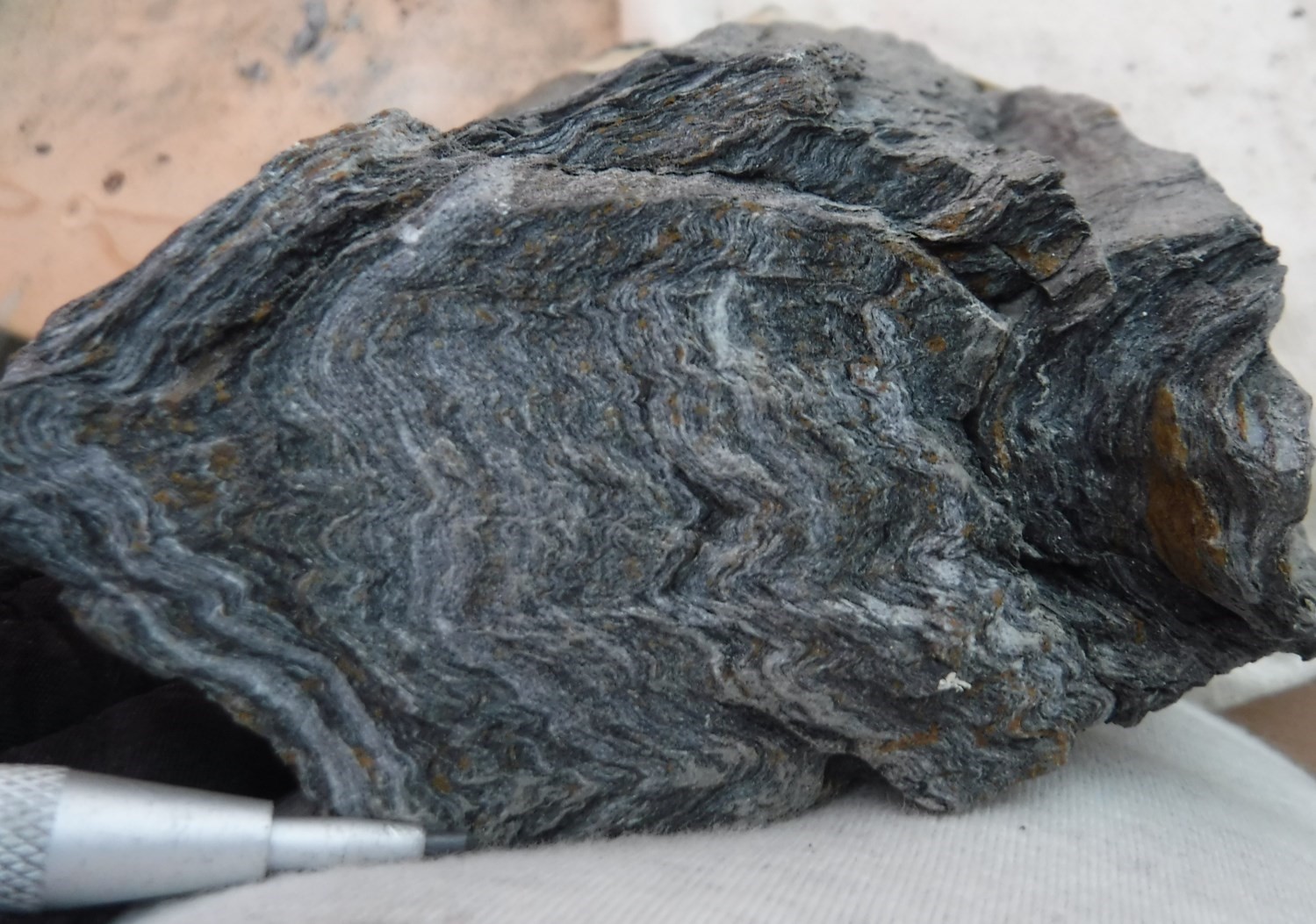 Mathieu and Beaudette (2019) report the presence of ankerite alteration in mudrock, wacke and arenite of the Spartan Group in the eastern part of the metasedimentary band (sheets 35G09, 35G16 and 35H13). Alteration appears weakens towards the extreme east. Poikilitic carbonate crystals (1-5 mm) develop independently of the composition of sedimentary beds. They are synkinematic to post-kinematic. Ankerite is locally oxidized to hematite.
Mathieu and Beaudette (2019) report the presence of ankerite alteration in mudrock, wacke and arenite of the Spartan Group in the eastern part of the metasedimentary band (sheets 35G09, 35G16 and 35H13). Alteration appears weakens towards the extreme east. Poikilitic carbonate crystals (1-5 mm) develop independently of the composition of sedimentary beds. They are synkinematic to post-kinematic. Ankerite is locally oxidized to hematite.
Spartan Group 1a (pPsp1a): Siltstone, Phyllite, Sandstone Locally Conglomeratic
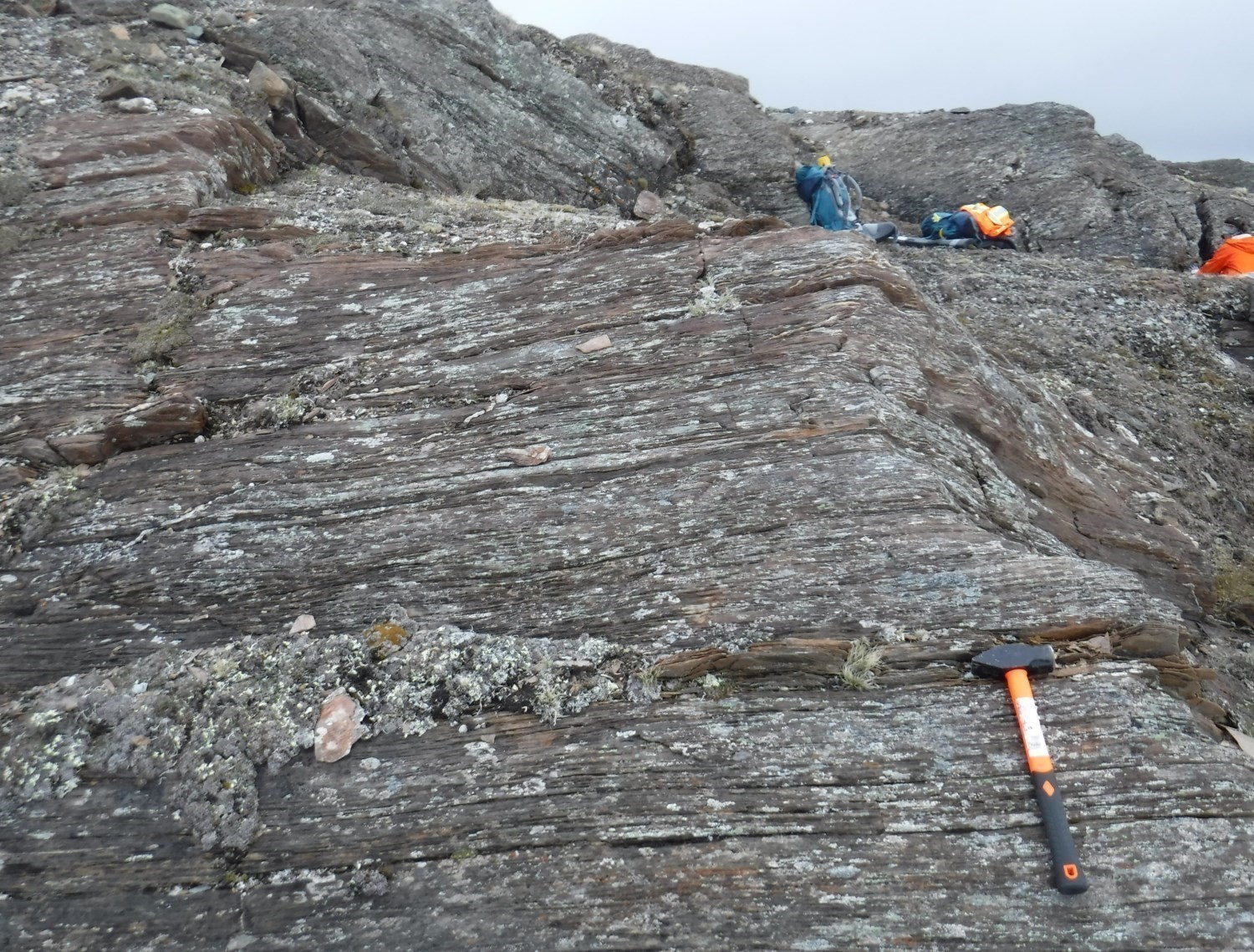
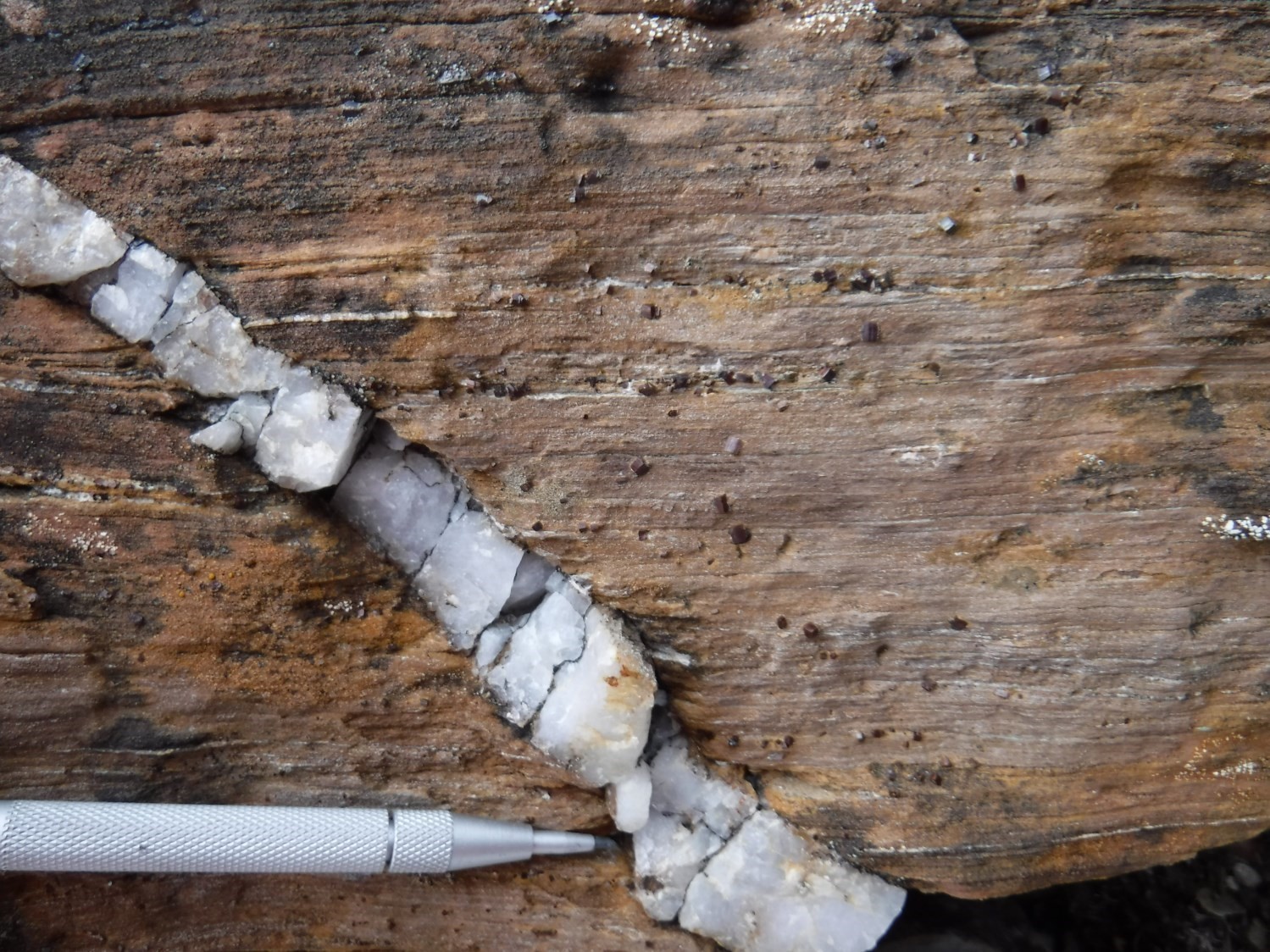
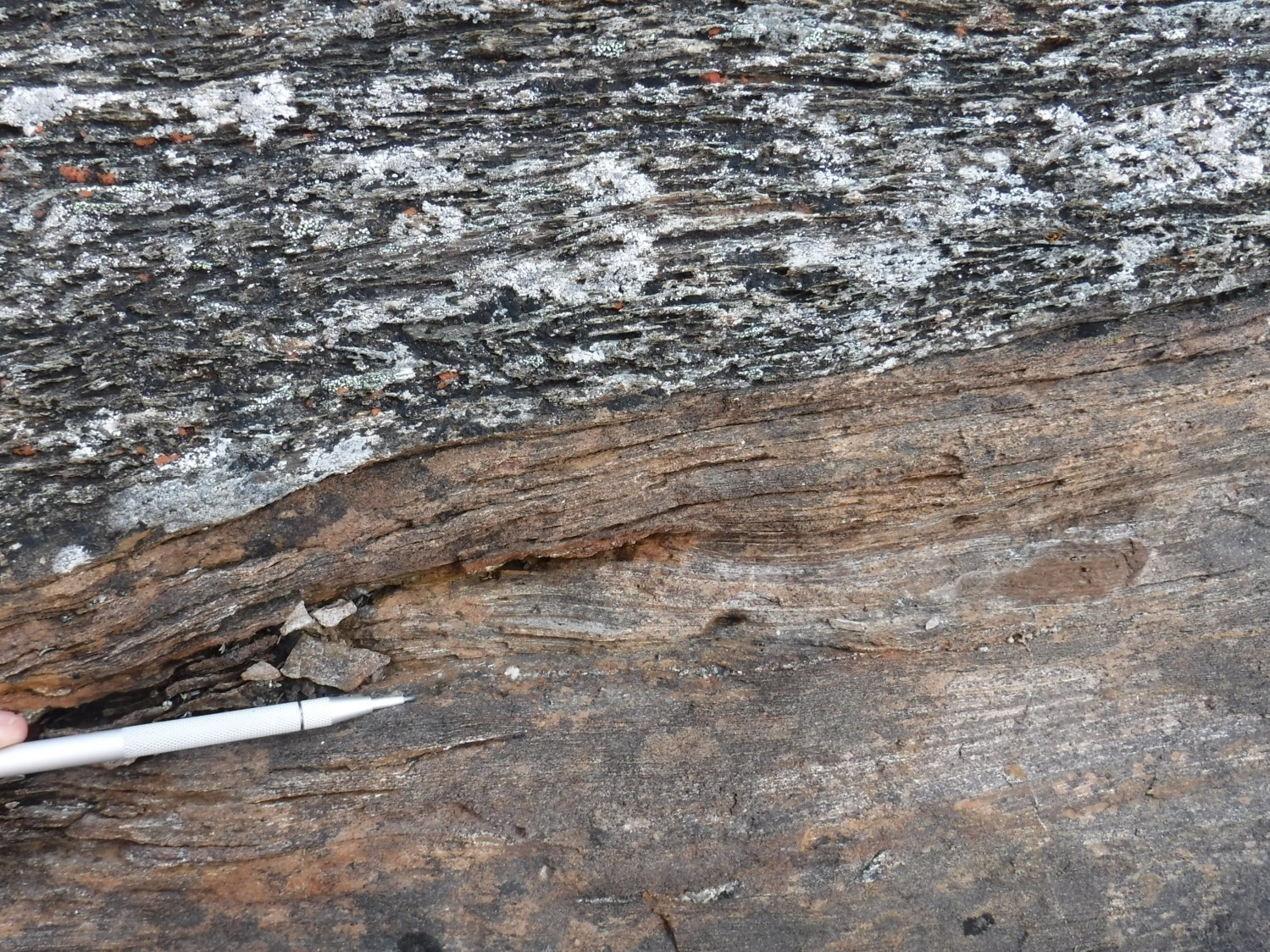 This informal subdivision was introduced by Mathieu and Beaudette (2019) to distinguish dolomite beds reported by earlier authors (Lamothe et al., 1984; St-Onge and Lucas, 1993), more specifically in the vicinity of thrusting of the Watts Group over the Spartan Group, in the eastern portion. This unit outcrops as metric beds interstratified with arenite and wacke of the main unit (pPsp1), the latter being locally mappable when their apparent thickness exceeds several decametres.
This informal subdivision was introduced by Mathieu and Beaudette (2019) to distinguish dolomite beds reported by earlier authors (Lamothe et al., 1984; St-Onge and Lucas, 1993), more specifically in the vicinity of thrusting of the Watts Group over the Spartan Group, in the eastern portion. This unit outcrops as metric beds interstratified with arenite and wacke of the main unit (pPsp1), the latter being locally mappable when their apparent thickness exceeds several decametres.
The unit has a ochre-brown patina and a brown sugar-coloured fresh surface. Outcrops are characterized by alternating millimetric beds of carbonate (60-85%), as well as varying amounts of quartz (5-25%) and talc (3-25%). Outcrop 18-BC-1060 displays bed truncation in several places, suggesting normal polarity towards the north. Late quartz veinlets and millimetric cubes of secondary pyrite are commonly reported. Carbonate crystals are fine to medium-grained with intergrown margins. They are poikilitic and include very fine quartz grains and talc flakes. Very fine quartz crystals form clusters and discontinuous millimetric beds with a saccharoidal appearance. Thin talc flakes are disseminated or arranged in flexure beds. Finally, it is noted that all primary phases define foliation.
Spartan Group 1b (pPsp1b): Pyrite-rich Graphitic Mudstone
Beds of oxide-carbonate facies iron formation are observed locally, as well as graphitic chert beds parallel to mudrock (outcrop 18-CL-2168). Mudrock contains local metric zones of massive sulphides.
Spartan Group 2 (pPsp2): Volcaniclastics
There is little information about this unit. A few felsic crystal or lapilli tuff beds are observed locally (Hocq et al., 1994).
Thickness and Distribution
The Spartan Group is divided into three strips that outcrop in the southern half of the Northern Domain. The eastern strip is 55 km long by 4 km wide (sheets 35G10, 35G09 and 35H13). The central area consists of three zones ~20 km long by 5 km wide (sheet 35G11). Located in sheet 35F09, the western strip is 30 km long by 10 km wide. According to Tremblay (1991), the thickness of sedimentary units in the western strip would be ~2000 m. Data from the Quebec Geomining Information System (SIGÉOM) indicate that outcrop zones located in the eastern strip have strong anomalies in potassium and thorium that contrast with the very low contents of mafic units of the Chukotat Group, in the south, and Watts Group, in the north.
Dating
None.
Stratigraphic Relationship(s)
The transition between Parent Group volcanics and Spartan Group sedimentary rocks was not observed. The nature of sedimentary rocks reflects a proximal to distal environment (St-Onge and Lucas, 1993; Lamothe, 1994). The Spartan Group’s composition and location on the edge of the Parent Group suggest that it represents an erosional apron on the margins of the volcanic arc (Lucas and St-Onge, 1992; Hocq et al., 1994). To the south, the Spartan Group structural base overthrusts the Chukotat Group along the Bergeron Fault. To the north, the structural top of the unit is overthrusted by the Watts Group.
Paleontology
Does not apply.
References
Publications available through Sigéom Examine
HOCQ, M., VERPAELST, P., CLARK, T., LAMOTHE, D., BRISEBOIS, D., BRUN, J., MARTINEAU, G. 1994. Géologie du Québec. MRN. MM 94-01, 172 pages.
LAMOTHE, D. 2007. Lexique stratigraphique de l’orogène de l’Ungava. MRNF. DV 2007-03, 66 pages and 1 plan.
LAMOTHE, D., PICARD, C., MOORHEAD, J. 1984. Région du lac Beauparlant, bande de cap Smith-Maricourt. MRN. DP-84-39, 2 plans.
MATHIEU, G., BEAUDETTE, M. 2019. Géologie de la région du lac Watts, Domaine Nord, Fosse de l’Ungava, Nunavik, Québec, Canada. MERN. BG 2019-04.
TREMBLAY, G. 1991. Géologie de la région du lac Lessard (Fosse de l’Ungava). MRN. ET 88-09, 32 pages and 2 plans.
Autres publications
Lucas, S.B., St-Onge, M.R. 1992. Terrane accretion in the internal zone of the Ungava orogen, northern Quebec. Part 2: Structural and metamorphic history. Canadian Journal of Earth Sciences; volume 4, pages 765–782.
St-Onge, M.R., Lucas, S.B. 1993. Geology of the eastern Cape Smith belt: parts of the Kangiqsujuaq, cratère du Nouveau-Québec, and lacs Nuvilik map areas, Quebec. Geological Survey of Canada; Memoir 438, 110 pages. http://doi.org/10.4095/183988.

